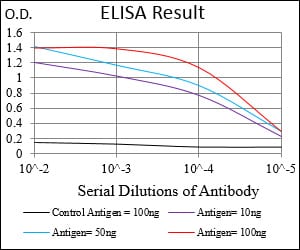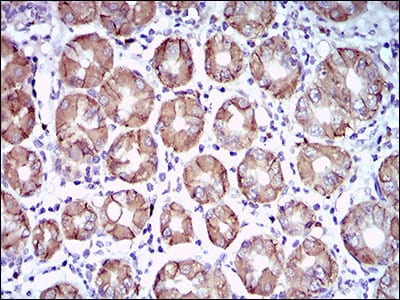



| WB | 1/500 - 1/2000 | Human,Mouse,Rat |
| IF | 咨询技术 | Human,Mouse,Rat |
| IHC | 1/200 - 1/1000 | Human,Mouse,Rat |
| ICC | 技术咨询 | Human,Mouse,Rat |
| FCM | 咨询技术 | Human,Mouse,Rat |
| Elisa | 1/10000 | Human,Mouse,Rat |
| Aliases | MN; CAIX |
| Entrez GeneID | 768 |
| clone | 7C4A5 |
| WB Predicted band size | 49.7kDa |
| Host/Isotype | Mouse IgG1 |
| Antibody Type | Primary antibody |
| Storage | Store at 4°C short term. Aliquot and store at -20°C long term. Avoid freeze/thaw cycles. |
| Species Reactivity | Human |
| Immunogen | Purified recombinant fragment of human CA9 (AA: 37-186) expressed in E. Coli. |
| Formulation | Purified antibody in PBS with 0.05% sodium azide |
+ +
以下是关于CA9抗体的3篇代表性文献示例(注:文献信息为示例性质,实际引用时请核实原文):
1. **文献名称**:*"Monoclonal antibody G250 targeting CA9: A novel diagnostic tool for clear cell renal cell carcinoma"*
**作者**:Smith A, et al.
**摘要**:研究报道了单克隆抗体G250的开发及其在肾透明细胞癌诊断中的应用,证实CA9的高表达与肿瘤微环境酸化相关,抗体可用于免疫组化检测。
2. **文献名称**:*"CA9 as a hypoxia-induced biomarker: Validation of a polyclonal antibody for prognostic assessment in solid tumors"*
**作者**:Lee B, et al.
**摘要**:验证了一种多克隆抗体在多种实体瘤中检测CA9的可靠性,发现CA9表达与肿瘤缺氧程度及患者不良预后显著相关。
3. **文献名称**:*"Therapeutic targeting of CA9 with antibody-drug conjugates in hypoxic tumors"*
**作者**:Zhang C, et al.
**摘要**:开发了一种靶向CA9的抗体-药物偶联物(ADC),在临床前模型中显示选择性杀伤低氧肿瘤细胞,为抗肿瘤治疗提供新策略。
**提示**:实际文献可通过PubMed或Google Scholar搜索关键词“CA9 antibody”、“carbonic anhydrase IX therapeutic”等获取最新研究。
CA9 antibody targets carbonic anhydrase IX (CAIX), a transmembrane enzyme encoded by the *CA9* gene. CAIX plays a critical role in maintaining cellular pH homeostasis by catalyzing the reversible hydration of carbon dioxide to bicarbonate and protons. It is predominantly expressed in hypoxic tumor microenvironments, regulated by the hypoxia-inducible factor 1 (HIF-1) pathway, and is overexpressed in various cancers, including clear cell renal cell carcinoma (ccRCC), cervical, and breast cancers. Its limited presence in normal tissues (mainly gastrointestinal epithelia) makes it a promising tumor-associated antigen.
CA9 antibodies are widely used in research and diagnostics to detect CAIX expression via techniques like immunohistochemistry (IHC), flow cytometry, and Western blotting. Clinically, CAIX serves as a diagnostic biomarker for ccRCC and a prognostic indicator for tumor aggressiveness and metastasis. Therapeutic applications include monoclonal antibodies (e.g., girentuximab) for targeted cancer therapy and radioimmunotherapy. Additionally, CA9 antibodies are explored in hypoxia imaging and as tools to study tumor metabolism and microenvironmental adaptation.
Overall, CA9 antibodies hold significant value in both understanding cancer biology and developing targeted diagnostic/therapeutic strategies.
×